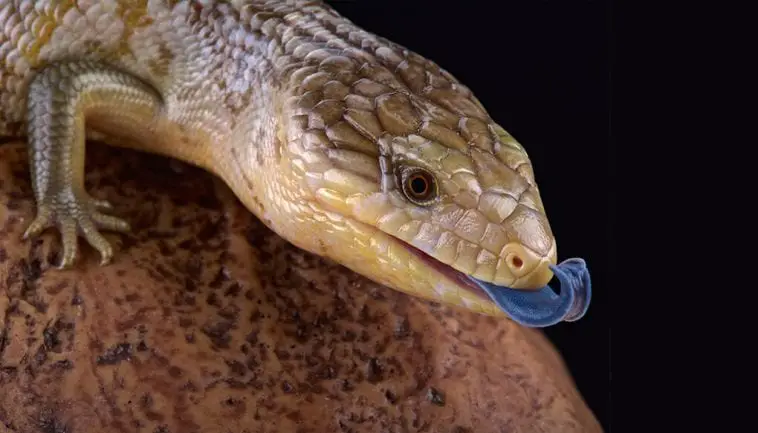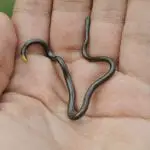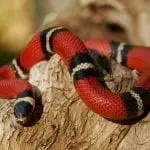Every pet owner should be committed to fulfilling his role to give his best care, precious time, and attention. Many people consider cats, dogs, and birds as domestic pets. But these days, some prefer those exotic types such as lizards.
There are lots of important things to know before getting a pet lizard. But if you are on the process of getting familiar with possible species to look for, these are the top five exotic lizards you can have as a pet.
Exotic Reptiles Store Tour
Credits: Paul Cuffaro
Leopard Geckos
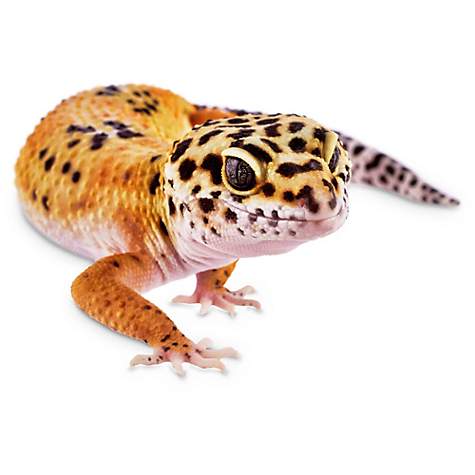
This soft-skinned type of lizard is the first thing those pet lovers will surely love. If you are a first-time reptile pet owner, you should have an eye for this little fellow. The leopard gecko, or Eublepharis macularius, can be found in many pet shops in the United States for over 30 years. It is one of the most common pet lizards today.
It has a small body size wherein adult females grow 7 to eight inches while adult males can grow up to 8 to 10 inches long. For hatchlings, they measure three to four inches in length. They are known as an invertebrate pet.
This adorable pet prefers meals such as roaches, live crickets, and mealworms. Since they are descendants of the south part of Asia, they thrive in warm and dry climates. It has a longer lifespan than other reptiles. When taken care of properly, this leopard gecko will stay with you on the average period of 15 years for males.
This species is nomadic. It has existed from various color morphs that are human manipulated. But bear in mind that this type of lizard may be calm, but loses its tail when held aggressively.
You can find these species in several pet stores, on online stores, or even reptile shows.
How to Take Care of Leopard Geckos
A leopard gecko is a wonderful pet if you research it thoroughly. The first thing to discover about these species is the environment it thrives in, which covers the lighting and temperature. An effective way to keep your gecko warm is to use an under-tank tape or heating pad. You can purchase one online or any pet shop.
Keep them away from heat rocks as they can cause burns to them. You can put a low-wattage light overhead for viewing. You can keep it on for 12 hours daily. Since they are generally nocturnal, no need for bask under a UVB light. The right room air temperature should be 73 degrees Fahrenheit and above.
When it comes to foods, you must provide them with live insects. They do not feed on vegetables or plants. You can also treat your beloved leopard gecko with super worms or waxworms at least once a week.
To give them essential minerals and vitamins, you can dust your insects. These insects, as well as a dusting powder, must be secured in a deep tin can or a plastic bag. Then, shake it gently. Make sure to protect your pet’s eye when putting these dusted insects into its cage.
Keep your pet lizard hydrated with fresh water placed in a shallow dish. See to it that the water dish is stable enough, so there is no tendency of spills. For the cage substrate, it should be maintained in dry condition. The adult and young leopard geckos must be able to climb out of this dish easily.
Blue-Tongued Skinks
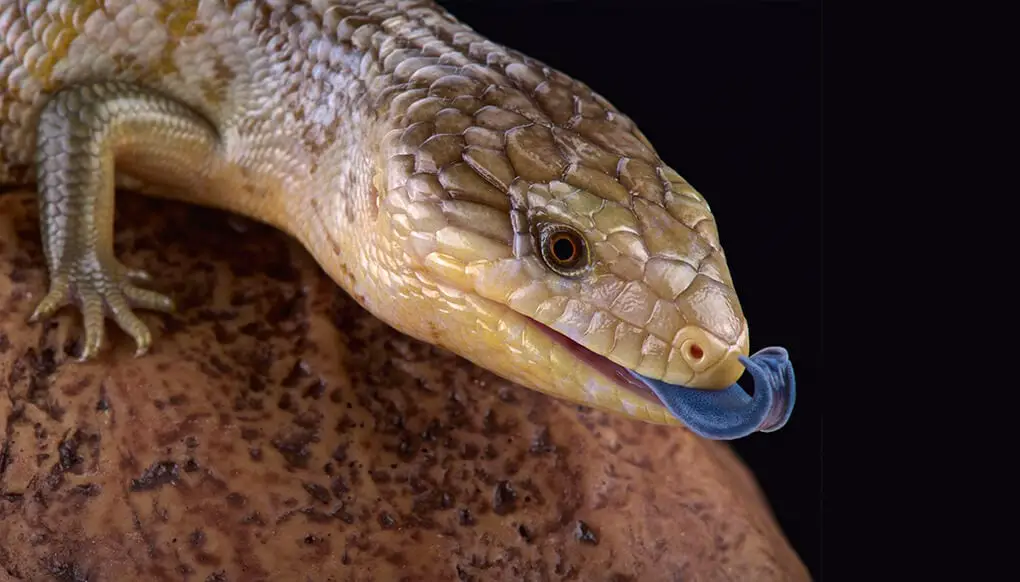
If you prefer a moderate size of pet lizard, then you can check on blue-tongued skinks. It grows about 2 feet in length and characterizes an elongated physical structure with short and stocky limbs. This species belongs to the genus Tiliqua along with other sub-species and recognized species.
Most of their species can be found in the mainland of Australia. Others inhabit the New Guinea and Indonesian islands. Blue-tongued skinks are known to be quiet predators, but they inflict a terrible bite when they felt aggression in handling them.
These species are a perfect choice for beginners because they are filled with great dispositions and amazing personalities. Even for those advanced hobbyists, they make a wonderful pet. It is due to the reason that they are quite difficult to breed. Some of their species are considered rare.
Some of its varieties are usually available seasonally, such as the northern blue-tongued skink. Others are often important and readily available, like the Indonesian blue-tongued skink. However, the Northern types are more preferred as pets.
One crucial detail to consider when buying from reptile pet stores is the physical condition of this gecko. Look for the most trustworthy and longest-operating pet shops. As soon as you find this species, you should check if they have clean toes and open ear canals. Make sure that there are no signs of retained shed skin. Be sure to inspect the lizard’s overall appearance to determine if it is in good health condition.
The cheapest blue-tongued skinks are the Northern skinks while the rate blue-tongued skinks like shinglebacks and Centralians are more expensive. When kept properly, your blue-tongued skink pet may live up to 20 years or even longer.
On the other hand, they open their mouths widely when they sense the threat around them. This is the way they exhibit as a potential intruder, thus, exposing their blue tongue. For other animals, it is an unpredicted warning.
The best part of handling a blue-tongued skink is that it is low maintenance. All you need to guarantee is to keep them in an average of 80 degrees F temperature. You can feed them with vegetables, fruits, and some small animals like pinkie mice or roaches.
Care Information About Blue-Tongued Skink
For baby blue-tongued skinks, they must live in a reptile enclosure made of plastic. They may also stay in a 20-gallon aquarium or a terrarium with screen tops (full).
For adult blue-tongues, they require 36 inches x 18 inches x 10 inches enclosures with a full top screen. Always remember that these species are terrestrial. They would love to have a more spacious floor area than a climbing area.
You should also know that both adult and juvenile blue-tongued skinks should be kept singly. However, you can also keep them together like a female and a male pair or all females together. Observe them closely how they treat one another. Once they begin to fight, place them in separate enclosures.
Green Iguana
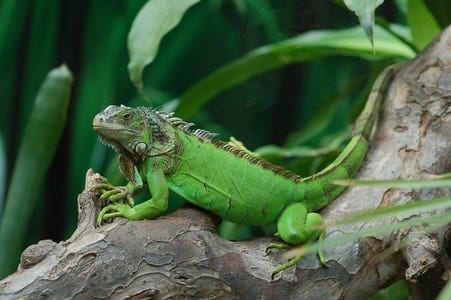
One of the most impressive reptiles in the pet industry is the green iguana (Iguana iguana). It displays a lot of dramatic features and bright colors. This type of exotic lizard is primarily arboreal. It spends most of its time off the ground.
They are often found in subtropical and tropical parts of South America and North America. However, they are commonly seen in the south part of Central America, Mexico, South America, Argentina, and Paraguay. These big lizards have also occurred throughout Southern Florida, the Greater Antilles, and even the Lesser Antilles.
You will notice distinctions in green iguana’s physical characteristics, which vary in its original location. For the populations in South America, they are known as Iguana iguana iguana. They are less tolerant of cold compared with the species in Central America, which are known for the taxonomic name, Iguana iguana rhinolopha.
These subspecies are alike, and there is one widely recognized species – the Iguana iguana. This green iguana has a horn on its nose, which can grow as a big flexible horn measuring more than ½ inch in length.
Green iguanas have huge nails that are helpful enough to climb. If you prefer a larger type of pet of 4 to 6 feet long, this is a good choice. In many circumstances, they are sold as a baby. But, you need to take good care of them very well to gain their trust.
They protect themselves against any danger around them by inflicting nasty bites. They also use their sharp and long tails by whipping them to keep something away. They also have razor-sharp nails, which become the common reason why some first-time reptile owners refuse to keep them. For experienced keepers, they wear leather gloves and nail clippers to reduce their chances of being hurt.
Proper Care of Green Iguanas
This specie of exotic lizard may grow up to 7 feet long and weigh an average of 20 pounds. When handled properly, a green iguana can live for 20 years.
In terms of caging, it is best to keep the baby green iguana to an aquarium (approximately 20 gallons long). You can keep those 18-inch long ones in this size of the enclosure. On the other hand, keeping small lizards in spacious aquariums would make it difficult for them to locate their water and food.
Adult green iguanas need a lot of space. They should live in an enclosure measuring 12 ft. long x 6 ft. wide x 6 ft. high. Since they are naturally arboreal, this six-foot height is crucial. Thus, the basic rule is that the cage should be twice as long as them.
Keepers use alfalfa pellets and plain rabbit pellet substrates for green iguanas. They do this since neonate species tend to eat substrates by accident. Eating such pellets does not pose a threat, unlike other substrates.
When it comes to temperature, they should be kept warm. For babies, a heat bulb works enough. But for the adult ones, there must be at least 6 light bulbs to heat their entire bodies. Experts suggest using double fluorescent UV light bulbs and incandescent heat bulbs to pave the way for vitamin D synthesis. To achieve optimum results, you can use both UVB and UVA.
Furthermore, a 120-degree Fahrenheit hotspot must be provided. This heat source must come from the top of your pet. This is done to achieve the engagement of the parietal eye to let the iguana thermoregulate.
Green iguanas can also decide on the temperature they prefer. Thus, a part of their cages must be cooler. You can set the temperatures like the mid-80s cooler end and 120 degrees high end. Never utilize heat pads, hot rocks, and other heat sources from the floors.
Green iguanas need to be hydrated constantly. This is the reason why there should be available water in their cages. Bear in mind that these smaller iguanas cannot find their water dishes. For this reason, it is paramount to mist them regularly. Do this every day and soak them two times a week to guarantee that they are kept hydrated.
With owners who started with juvenile green iguanas, they should mist their pets occasionally. As much as possible, there must be a big container where the lizard can soak.
In terms of food, its dietary needs must include natural foods (raw). There are “iguana foods” available in the supermarket. Some of the excellent foods for your green iguana are dandelions, collard greens, yellow squash, turnip greens, and whole green beans. It is also recommended by experts to provide them with fruits at least a week.
Generally, a baby green iguana does not bite. Yet, excessive handling must be prevented until it feels comfortable with its new habitat. They are smart and friendly pets. They are capable of recognizing their keepers. Over time, they tend to become very affectionate, making them the best reptiles to make as pets.
Water Monitor
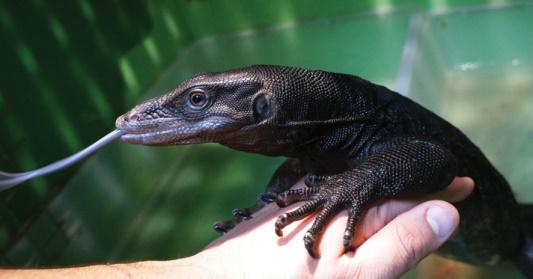
If you are a monitor enthusiast, you are probably considering an Asian water monitor (Varanus Salvator). It is often found across Asian countries, and its size is next to Komodo monitors. They belong to the most intelligent big lizards.
Their species originated from Southeast Asia. It has been reported that they have evolved over many years to be able to live in both urban and wild settings. They do this means of survival through various adaptations.
Water monitors have proven how they are capable of adaptation. They are also found in the regions of Northeast India and have flourished in various landscapes throughout such range. They even exist in other urban settings such as Bangkok, Thailand.
Adult water monitors can grow up to a maximum length of 9 feet with 6 feet as the average size. They need a spacious room to dwell in. They have a challenging husbandry requirement. Yet, numerous hobbyists embrace this challenge and start discovering the benefits of keeping this “Urban Dinosaur”.
These lizards also inflict a terrible bite. Other defensive attacks they make include scratching, fecal spraying, and tail whipping. On the other hand, hobbyists also observed the intellectual and social capacity of water monitors.
Information on the Proper Care of Water Monitor
Generally, these Varanus Salvator species prefer living in lowlands, but they are also found in elevated spots up to 6000 feet (above sea level). They can be harvested in a large number for their body parts, meat, and leather.
An Asian water monitor is considered as the 3rd longest lizard next to the crocodile monitor (or Varanus salvadorii) and the komodo dragon (or Varanus komodoensis). They grow at an impressive length in a short time.
For hatchlings, they measure around 10 inches in length and grow up to 7 feet within a year. But take note that adult sizes vary on some factors such as husbandry parameters, genetics, diet, and locality. Female water monitors are normally smaller than males.
Their life expectancy may reach an average of 20 years in captivity. Nowadays, there are various enclosure options provided to hobbyists.
A baby water monitor can live in an enclosure of a 40-gallon terrarium (approximately 36 inches x 18 inches x 16 inches). Do not keep this pet giant in an actual tank. It is due to the reason that a glass enclosure does not maintain the humidity and temperature required.
If you got yearlings, they could survive in an enclosure with sizes 4 feet x 4 feet x 4 feet. For adults, you should provide them with an enclosure of 8 feet x 6 feet x 8 feet. If you wish to decorate them with some habitat products for lizards, use vertical spaces.
These water monitor lizards are known as avid climbers and active species. Providing them with a furnished enclosure is exploring their mental and physical well-being. You should be cautious when choosing a fragile décor such as live plants. They can be damaged even by those gentle giants. For vertical spaces, they can be created by adding other items like logs, branches, and shelves, which serve as a basking area.
Well-heated water monitors must be basked for a short period only. Then, check on their enclosures before putting them back to a basking area. This is the right way to do thermoregulation, which must be done daily. Proper temperatures, humidity, and lighting are essential factors that will keep your pets happy and healthy.
The basking surface should be kept in 125 to 140 degrees Fahrenheit temperature. It is best to place various bulbs organized in a parallel position to one another. It prevents burns since the water monitor can achieve the right temperature.
A water monitor resides in regions near the equator where there is no fluctuation in temperature. For ambient temperatures, these enclosures must be maintained at around 80 degrees Fahrenheit.
A large lizard must have a huge appetite, as well. A baby monitor is highly insectivorous.
For diets comprising of gut-loaded crickets, they should vary on roach species as an ideal choice. Insects can be dusted with vitamin D3 supplements and calcium.
Russian Legless Lizards
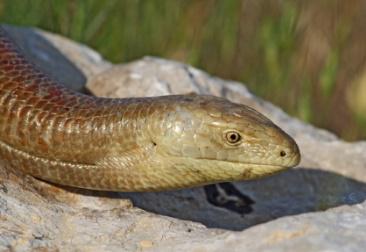
Also called Scheltopusik, this European legless lizard, or Pseudopus apodus, comes in an unusual huge form that can be categorized as the Glass lizards. This is because of their special ability to disarticulate their tails when threatened.
They are often mistaken for snakes, but they differ in terms of external ear openings and moveable eyelids. They are generally calm and can be handled even when in captivity. Yet, they bite, musk, and capable of caudal autotomy (or tail breaking when trying to escape).
You can find these legless lizards on various reptile expos and stores. But the truth is that they are not completely legless. They got very small rudimentary rear limbs, which measure only 2 millimeters.
The term scheltopusik is from the Russian word means ‘yellow belly’. This is the biggest legless lizard that can grow up to 4 feet. They are also called “giant glass lizard or European glass lizard.
Taking Care of Scheltopusik Lizards
Your terrarium for Russian legless lizards must be horizontally-oriented. You need to provide low branches for climbing. Make sure that these branches are fully secured and should not be affected by the lizard’s weight.
You can also provide some rocks into their enclosures. To guarantee the security of these cage furnishings, it is best to add adhesives such as epoxy. For ground areas measuring 4 ft. x 4 feet, you can keep two scheltopusiks living comfortably.
Since they are typically diurnal, there should be UVB lighting. You can also provide a substrate to allow burrowing. Let them feel more comfortable by adding hiding places like hollow logs or a hide box. Just like other reptiles, these legless lizards must feel secure, which results in good health.
As a reptile owner, you should do your research before buying one from a different source. They are completely different from keeping dogs or cats where you just go to any store and buy some food. They require special care and attention to survive. You should be fully aware of their diet, habitat requirements, lifespan, and the standard size when fully grown.
You can choose a starter lizard as your pet, such as a blue-tongued skink or a leopard gecko. They are easier to handle compared with an iguana or a chameleon. A trusted local veterinarian or reputable pet stores online are the best resources for selecting the right lizard based on your pet handling skill level.
One important reminder, do not release them into the wild if you want to let them go. You can offer your pet for adoption. Otherwise, take them to pet rescues accepting lizards because this is the right thing to do.

